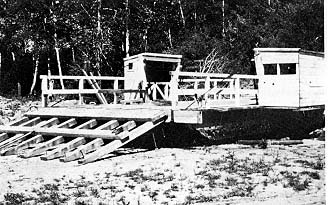North Saskatchewan River 22-56-5-4
This crossing was the site of the old Moose Telegraph Station, installed in 1896 on the line from Edmonton to Battleford. Early settlers in the area chose the name "Tyrol" for the first post office established in 1910, but when this was moved in 1911, the name changed to "Mooswa." It was known by this name until 1928, when it was changed to "Lindbergh," reportedly in honour of Charles Lindbergh, the American aviator. By 1911, with more settlers, a store and a post office, a means of river crossing became a necessity and local residents with their teams of oxen worked hard to build a road down to the river.
There was great excitement one spring day in 1911 when the telegraph station received the message that a ferry, built in Edmonton, was on its way down river. Archie Pasmore and John Chilabeck went down with their horses to pull it to shore when it arrived. It was soon connected to the cable and put into service, to the great benefit of local residents who had previously used the Hopkins ferry about twenty miles upriver. At that time the railroad was at Kitscoty, to the south, and the ferry was used to transport grain and livestock across the river.

Cattle drives were organized for shipping via Islay to the ferry crossing, where the ferry-man undertook the arduous task of ferrying them all across - some on the ferry, some swimming behind it. These drives usually took place in the fall after the trees had lost their leaves so that runaway cattle could more easily be seen and brought back to the herd. Winter crossings were made on the ice, but there is no record as to how spring and fall crossings were accomplished.
Nora Omness Ronaghan Williamson tells a story of the time she had to cross at the ferry crossing in 1918 after attending a dance at Ferguson Flats. When she reached the crossing after sliding down the long hill on her horse, she could see that the ice was already melting. She told her horse, "Shady, it's up to you to get me across." He very carefully tiptoed over the trail, which could just be seen across the ice, with the with trickles of water closing in behind him. Close to the opposite shore he broke through the ice and, after making several lunges to force his way through the slush, he finally regained his footing and got Nora out on to the river bank. They were both soaked with the icy water and the ferryman, who had been watching their perilous journey, put a blanket over Shady, who was trembling with cold and exhaustion. Nora's clothes were dried by the fire in the ferryman's shack and he gave her a piece of bread thickly spread with butter and honey. As they watched the progress of melting water over the ice, they realized what a close call it had been ..
Haestie, Elizabeth Ferries and Ferrymen in Alberta, Glenbow Museum 1986


